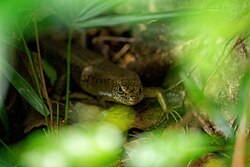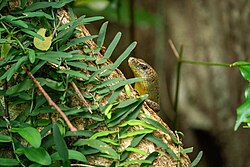Biology:Eutropis tytleri
| Eutropis tytleri | |
|---|---|

| |
| Near Shoalbay, Andaman Islands | |
| Scientific classification | |
| Domain: | Eukaryota |
| Kingdom: | Animalia |
| Phylum: | Chordata |
| Class: | Reptilia |
| Order: | Squamata |
| Family: | Scincidae |
| Genus: | Eutropis |
| Species: | E. tytleri
|
| Binomial name | |
| Eutropis tytleri (Theobald, 1868)[2]
| |
| Synonyms[3] | |
| |
Eutropis tytleri (common name: Tytler's mabuya) is a species of skink, a lizard in the family Scincidae. The species is endemic to the Andaman Islands, India .
Etymology and Taxonomy
E. tytleri is named after British naturalist Robert Christopher Tytler,[4] who probably collected the type.[3] It was described by the British naturualist William Theobald in 1868, who was employed by the Geological Survey of India at the time.
Habitat
The preferred natural habitat of E. tytleri is forests, at altitudes from sea level to 150 m (490 ft).[1] It can be found in native broadleaf forests, agricultural fields, coconut plantations, and around human dwellings and gardens.[1]
Description
A large species of skink, E. tytleri may attain a snout-to-vent length (SVL) of 15 cm (5.9 in). The tail is long, from 1.5 to 2.2 times SVL. Dorsally, it is bronzish brown. Ventrally, it is light yellow.[5] E. tytleri is thought to be the largest extant skink species native to the Indian subcontinent.[6]
Behavior
E. tytleri is crepuscular. It has been observed climbing tree trunks to a height of 3 m (9.8 ft), and is also active on the ground.[5]
Diet
E. tytleri preys upon insects, frogs, and small reptiles.[5]
Reproduction
The mode of reproduction of E. tytleri is unknown.[3][6]
Relationship with humans
While the forests to which E. tytleri lives appear to be shrinking as human use of its habitat increases, this species population does not appear to be in decline.[1] E. tytleri appears able to adapt to new, human-created habitats and is known to inhabit many human-used spaces.[1] Furthermore, this skink is not known to be utilized by people and does not appear to be under any specific threat.[1]
References
- ↑ 1.0 1.1 1.2 1.3 1.4 1.5 Mohapatra P (2021). "Eutropis tytleri ". The IUCN Red List of Threatened Species 2021: https://dx.doi.org/10.2305/IUCN.UK.2021-3.TLTS.T172647A1358667.en. Accessed on 04 June 2022.
- ↑ Theobald W (1868). "Catalogue of Reptiles in the Museum of the Asiatic Society of Bengal". Journal of the Asiatic Society of Bengal, Calcutta 37 (2) (extra number 146): 7-88. (Scincus tytleri, new species, p. 23).
- ↑ 3.0 3.1 3.2 Eutropis tytleri at the Reptarium.cz Reptile Database. Accessed 19 July 2014.
- ↑ Beolens, Bo; Watkins, Michael; Grayson, Michael (2011). The Eponym Dictionary of Reptiles. Baltimore: Johns Hopkins University Press. xiii + 296 pp. ISBN:978-1-4214-0135-5. (Mabuya tytleri, p. 269).
- ↑ 5.0 5.1 5.2 Chandramouli SR, Amarasinghe AAT (2020). "On two poorly known, insular skinks, Eutropis tytleri (Theobald, 1868) and E. andamanensis (Smith, 1935) (Reptilia: Scincidae), endemic to the Andaman Islands, India". Taprobanica 9 (1): 31–38.
- ↑ 6.0 6.1 Das I (2002).
Further reading
- Boulenger GA (1887). Catalogue of the Lizards in the British Museum (Natural History). Second Edition. Volume III. ... Scincidæ ... London: Trustees of the British Museum (Natural History). (Taylor and Francis, printers). xii + 575 pp. + Plates I-XL. (Mabuia tytleri, p. 187).
- Boulenger GA (1890). The Fauna of British India, Including Ceylon and Burma. Reptilia and Batrachia. London; Secretary of State for India in Council. (Taylor and Francis, printers). xviii + 541 pp. (Mabuia tytleri, pp. 191–192).
- Das I (2002). A Photographic Guide to Snakes and other Reptiles of India. Sanibel Island Florida: Ralph Curtis Books. 144 pp. ISBN:0-88359-056-5. (Mabuya tytleri, p. 112).
- Smith MA (1935). The Fauna of British India, Including Ceylon and Burma. Reptilia and Amphibia. Vol. II.—Sauria. London: Secretary of State for India in Council. (Taylor and Francis, printers). xiii + 440 pp. + Plate I + 2 maps. (Mabuya tytleri, p. 270).
Wikidata ☰ Q3012485 entry
 |



